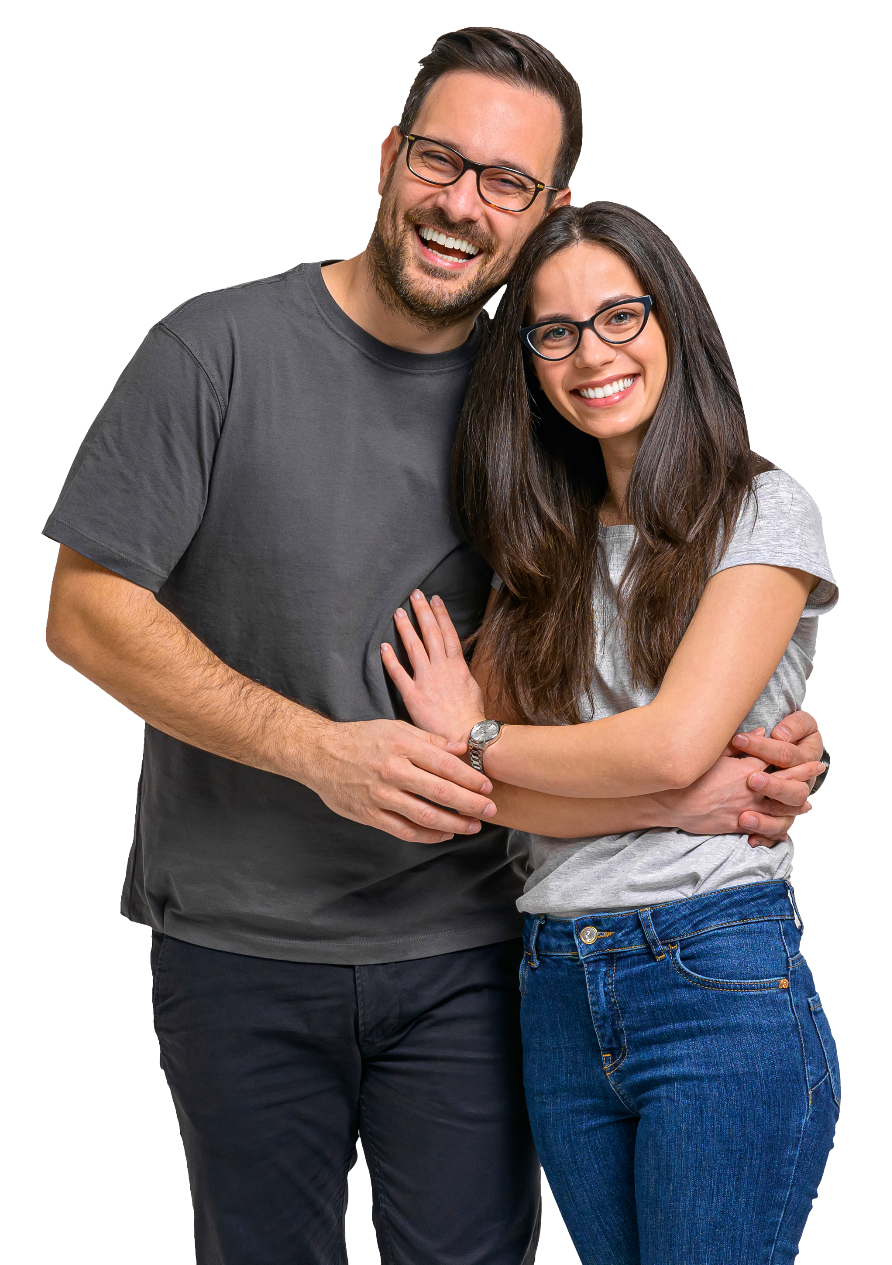%20(Blog%20Banner)%20(8).png)
20/20 Pro to Pro Series
PART ONE: 20/20 Pro to Pro Series
According to The American Board of Optometry, Americans are on their computers and other electronic devices more than ever before—an average of 7 hours a day—and it's causing an unprecedented amount of eye-related symptoms. Clinicians commonly refer this to as Digital Vision Syndrome (DVS), or Computer Vision Syndrome (CVS), with headaches, dry eyes, neck pain, and eyestrain or asthenopia being some common complaints. An estimated 50-90% of adults who work on computers and children who stare at tablets or other devices report symptoms of DVS.
A lot goes into keeping the eyes aligned; our eyes must constantly re-adjust and focus as we scan the screen. Six muscles control each eye. Two extraocular muscles, the medial rectus, and lateral rectus control horizontal movements by constantly alternating contraction and relaxation—four muscles per eye control vertical balance. When we consider that our eyes move about 240 times a minute, it's easy to appreciate the workout our eye muscles get every day. Not only are our eye muscles in constant movement, but our visual system also interprets countless images throughout the day and reconciles information from both peripheral with central vision. It is not surprising, then, that undetectable subtle eye misalignments, or phorias, missed by standard cover tests, may also play a role in symptoms associated with DVS, as eye muscles struggle to keep the eyes aligned during convergence. These subtle undetected phorias are typically overlooked and unaddressed or uncorrected and may cause DVS symptoms by inducing trigeminal dysphoria.
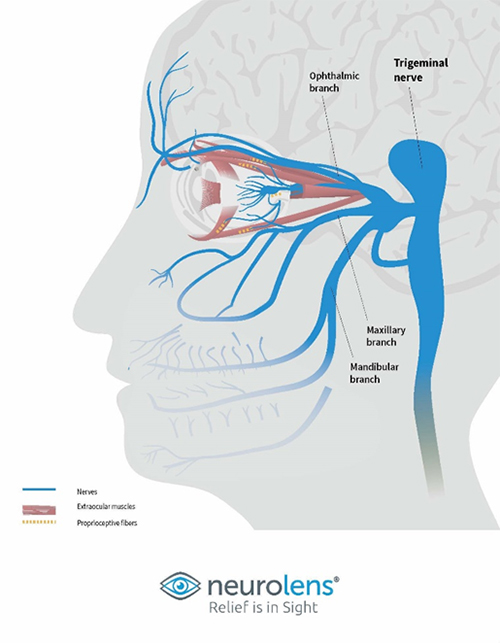 |
| Figure 1 Trigeminal Nerve |
The Trigeminal nerve (Fig.1) is the fifth cranial nerve, with one of its three branches innervating the eye. The ophthalmic branch of the trigeminal nerve carries sensory signals to the brainstem. It, too, has three branches: the frontal nerve, the lacrimal nerve, and the nasociliary nerve. These three nerve branches provide sensory nervation to the conjunctiva, upper eyelids, lacrimal glands, cornea, and pupil.
With the eyes' constant realignment of central and peripheral vision, the extraocular muscles' proprioceptive fiber signals travel the trigeminal nerve's eye-related branch, overstimulating it and causing symptoms associated with DVS. Although double vision may not be a reported symptom of digital eye strain, small undetectable amounts of diplopia likely occur.
Typically, phorias cause diplopia or double vision and are correctable with a prism in glasses. But small, nearly undetectable amounts of prism to correct non-diplopic phorias would require a customized placement and small incremental amounts of prism unavailable in standard optical lenses. Neurolens solves the problem by incorporating a contoured prism into its lens designs, placing the prism correction where it’s needed most—as well as offering a device that can detect eye misalignment as small as 0.01 prism diopters.
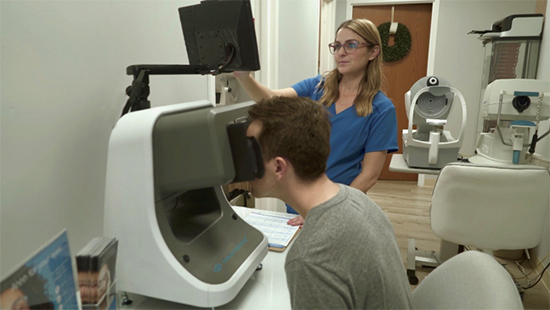 |
| Figure 2 Neurolens Measurement Device Gen 2 NMD2 |
The NMD2 is easy to use and results in accurate, non-subjective measurements. The test takes about two minutes and can be easily administered by a technician. Doctors prescribe Neurolens with precise contoured prism lenses using the measurements gained by the device, thereby relieving patients of DVS symptoms, and achieving clear, crisp and a comfortable binocular fusion.
PART TWO: 20/20 Pro to Pro Series
Google “digital eye strain,” and a whopping 107,000,000 results populate. Type in “computer vision syndrome,” and another 68,400,000 results bombard your screen. Topping the list is a link to The American Optometric Association’s website, where you will discover that the average American worker spends seven hours a day on the computer. But even this figure may be understated.
In a 2021 Ipsos poll conducted on behalf of the New Global Myopia Awareness Coalition (GMAC), children and their parents spend double the time they did pre-Covid staring at digital screens. The poll, conducted to measure the growth rate of myopia in children due to near-focus trends, high- lights the incredible effect that the rapid acceleration of digital device usage is having on our vision.
In Neurolens Relief Is in Sight Part 1, which was featured in the April issue of 20/20’s Pro to Pro series, we discussed trigeminal dysphoria, a syndrome caused by the overstimulation of the fifth cranial nerve during prolonged computer screen use as the eyes attempt to reconcile peripheral and central vision during convergence. This overstimulation causes symptoms associated with Digital Vision Syndrome (DVS), including asthenopia or eye strain, dry or watery eyes, neck and shoulder pain, and headaches.
A Neurolens study of over 160,000 people showed that 2 out of 3 people experience symptoms from eye misalignment. Yet only 1 in 10 people report these symptoms to their eye doctor. The reason is simple: Most people don’t know that their eye doctors might have solutions available. In many ways, doctors are detectives; they must listen intently to the patient, analyze symptoms and ascertain their root causes. Asking the right questions is imperative in identifying trigeminal dysphoria. Often, patients come to the office stating vague complaints such as “my eyes water” or “the computer is blurry.” In particular, patients may not correlate symptoms like dry or watery eyes—or even the sensations of dizzinessor motion sickness—to prolonged computer use. Typically, patients don’t connect symptoms to the cause; they just want their eyes to work and see correctly without discomfort or effort. (FIG. 1)
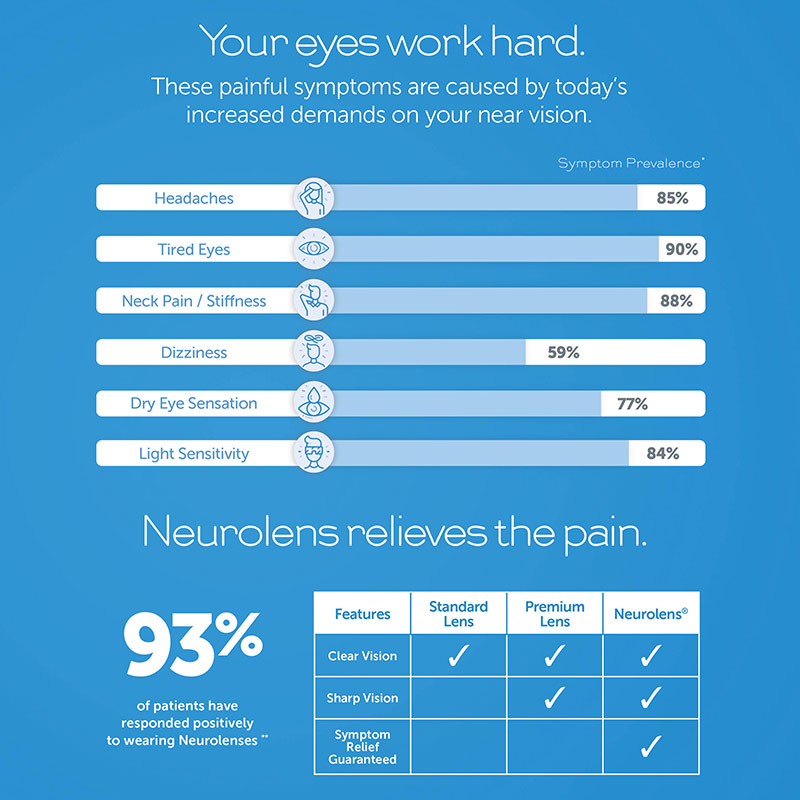
FIG. 1
What a patient doesn’t say is as important as what they do say. For instance, the patient may take their neck complaint (an increasingly common symptom of eye misalignment) to their PCP but not their optometrist. To this end, a questionnaire designed to tease out symptoms of eye misalignment is the easiest way for the patient to denote signs they may otherwise fail to mention to the doctor, thereby aiding in the diagnosis of trigeminal dysphoria. Neurolens has an easy-to-use questionnaire called Lifestyle Index, which is available as both a printed form and an easy-to-complete online screener.
Once the patient symptomology has been ascertained, the Neurolens Measurement Device, Gen 2—or NMD2—tests for these subtle eye misalignments or phorias with an accuracy and consistency unattainable by standard cover tests, which are often subjective and have a higher error rate. The NMD2 starts by measuring pupillary distance (PD) while the patient looks at moving graphics. After determining the PD, a base alignment is performed wherein the system looks for eye turn in the eye that is not presented a target on which to fixate, detecting any dissociated phorias. Then it moves to an associated test or a fine alignment measurement. During this part of the test, the patient sees moving peripheral images as the target alternates centrally between the left and right eye. Eventually, the target adjusts to neutralize any eye movement or fixation disparity. The NMD2 then adjusts its optics to simulate a closer accommodation distance (50 cm) and establishes near pupillary distance during convergence. The device then measures both base and fine alignment at this near distance. The final results confirm monocular pupillary distance and alignment at both near and distance, along with the AC/A ratio. It also detects horizontal and vertical misalignment at both near and distance, which in most cases are different, warranting a contoured prism to correct each one appropriately. The device also provides a recommendation of the prism value that the patient might need to relieve their symptomology known as the Neurolens value. This can be readily used by the doctors as a prescriptive guideline. According to their website, the NMD2 collects thousands of data points per patient and can identify eye misalignment as small as 0.01 Prism Diopters, a level of specificity unmatched by cover tests or other common methods.
The measurements gained by the NMD2 help the doctor accurately diagnose trigeminal dysphoria and prescribe Neurolenses. Available in Single Vision, Office and Progressive designs, Neurolenses employ a customized contoured prism in order to intelligently place the prism power where it’s needed most, effectively addressing the eye misalignment and its corresponding symptoms.
For many practitioners, prescribing prism elicits anxiety; but it shouldn’t. Diagnosing DVS-related trigeminal dysphoria should be standard practice for all patients and incorporated into their annual eye exam. Good vision is not just about clarity; it’s about fusion, binocularity and comfort.
PART THREE: 20/20 Pro to Pro Series
Neurolens: The Patient Experience, the Handoff and the Dispenser’s Perspective
When educating a patient about Neurolens, everyone in the practice is involved in the Neurolens process, from the technician to the doctor to the optician. Therefore, it is imperative that all staff are knowledgeable on eye misalignment and trigeminal dysphoria, and how Neurolenses are proven to help alleviate symptoms in the vast majority of wearers. Staff knowledge creates confidence when educating the patient about Neurolens; this, in turn, confers confidence in the patient.
Engaging staff members through hands-on training and educational videos provided by Neurolens elicits enthusiasm. Team effort makes the flow seamless for the patient. Testing each staff member on the NMD2 will give them a better understanding of the patient-facing experience and help identify staff members who make good Neurolens candidates, giving these staff members the opportunity to tell patients about their own personal experiences with the product. Enthusiasm is infectious, and there’s nothing like testimony from a staff member who wears Neurolens and is reaping its benefits. Knowing keywords and having a solid understanding of the NMD2 and Neurolenses will facilitate authentic messaging when speaking to the patient. Roundtable discussions following the training opens the opportunity to clarify questions and hear how others might explain the process, symptoms and benefits of Neurolenses to the patient.
The Neurolens process is straightforward. After determining a patient’s symptomology through a short questionnaire—available in both digital and print form—the technician/optician sets up the patient at the NMD2 and prepares them for the test, which takes less than two minutes. The first thing the patient sees is the word Neurolens. Next, the patient is shown an underwater scene, where a submarine with a yellow propeller appears. The technician instructs the patient to focus on the yellow propeller as the submarine moves into the distance while the machine measures the distance PD to a 10th of a millimeter. Next, fish appear to be swimming all around while the patient focuses into the distance (farther than 6 m). Next, six circles appear, and the machine measures distance base alignment or dissociated phorias. Each eye sees something different, but the brain combines them into one picture. The device measures how much eye movement is present. Even though the target is stationary, the patient perceives it as moving from side to side. The device then presents fish swimming all around to both the eyes while the yellow propeller is being flashed to one of the eyes. The machine measures distance fixation disparity or fine alignment during this presentation. The process is then repeated at near (50 cm). The machine measures near PD, near base and fine alignment. The device then provides a prescriptive recommendation that the doctor can readily use. All this happens in less than two minutes, which is far less than traditional diagnostic methods.
Next, the patient is taken to the exam room, where they discuss their results with their doctor. Patients trust their doctor; therefore, their recommendation strongly impacts patient confidence and likelihood to purchase. Viewing a simplified summary of the NMD2 measurement results with the patient makes it easy to explain their misalignment and affords the doctor an opportunity to explain in simple terms how Neurolenses correct this misalignment. Examples of clear statements that make it easy for the patient to correlate symptom relief with Neurolenses might be along the lines of, “Neurolens allows your eyes to work together as they’re supposed to, without straining. Relieving eyestrain may reduce or alleviate symptoms such as neck strain, headaches or even motion sickness.” Patient-friendly brochures about Neurolens are always helpful, as is directing patients to explanatory videos available on the Neurolens website or YouTube channel.
Next is the all-important doctor-to-optician handoff. Mentioning the prescription for Neurolenses and the patient symptoms being addressed during this handoff process allows the optician to echo keywords used by the doctor when guiding the patient through the dispensing process. Many opticians find it compelling to explain the cost/benefits of Neurolens by comparing it to the cost incurred for other treatments in attempts to relieve the symptoms of trigeminal dysphoria such as chiropractor, massage/physical therapy, doctor visits and medications.
Glasses that are aligned and fit properly make a difference in how well the patient sees, especially with prism lenses. The patient may need time to adjust and feel comfortable, as with any glasses. Many people adapt rapidly while other others may need more time to feel comfortable and managing expectations during the dispensing process is important to maximizing outcomes for all patient types. Patient testimonials abound that indicate any adaptation period is worth the relief experienced. Patients become very emotional when sharing how life changing Neurolens has been for them with many having suffered for years without effective treatment.
With many positive patient and doctor testimonials available, optometrists can feel confident prescribing Neurolenses. And opticians can be comfortable dispensing Neurolenses as well. As Ray Corbin-Simon, OD, of Piscataway, N.J., says, “It’s been amazing. The pain that I used to feel in my neck has dissipated, and I can comfortably sit and read with my eyeglasses, which I couldn’t do before; I haven’t seen a chiropractor since then. I’m a true example that this does work.”
Watch 20/20 Pro to Pro Perspectives: Neurolens Part 3
PART FOUR: 20/20 Pro to Pro Series
Provide Relief and Increase Patient Traffic and Revenue
In this age of online optical shops, deep discount chain stores and plenty of brick-and-mortar competition, settling for mediocracy or ordinariness in your practice is a surefire way to get lost in the crowd. Use specialization as an opportunity to attract new customers. With Neurolens, you will offer solutions not easily found elsewhere and certainly not available online. Offering services that solve problems and provide relief for patients build loyal customers—the types of customers who tell their friends and family about their outcomes. There is no better way to grow your business than happy patients spreading the word.
Neurolens technology provides a proven and reliable way to generate cash flow while providing exceptional service to your patients. As stated in a previous article in this series, a study of over 160,000 people conducted by Neurolens showed that more than 2 out of every 3 people have symptoms of eye misalignment, a phenomenon known as trigeminal dysphoria. Trigeminal dysphoria results when the fifth cranial nerve overstimulates during prolonged screen use as the eyes attempt to reconcile peripheral and central vision during convergence. This overstimulation causes symptoms of digital vision syndrome, including eyestrain, dry or watery eyes, neck and shoulder pain, and headaches. Neurolens effectively addresses these symptoms by employing a contoured prism positioned strategically through the lens, placing the correction where it is needed most.
There are a few reliable ways to increase profits and stimulate practice growth. One is to attract new patients to your practice, and the other is to upsell to your loyal repeat patients. Neurolens makes both scenarios possible. First, Neurolens is actively pushing new patients into their provider practices with direct-to-consumer advertising, marketing co-op programs for providers and their popular online “Take The Test” and “Find A Doctor” tools. In fact, almost 20 patients per day request appointments with Neurolens providers through the Neurolens website! They also invest highly into maximizing the patient experience once in the practice, making sure your conversion rates remain high. Finally, when we consider that trigeminal dysphoria can be present in people with refractive error and emmetropes alike, the opportunity for selling Neurolenses becomes endless. In fact, many Neurolens patients wear plano Neurolenses over their contact lenses while doing near work—and these patients have some of the highest symptom relief scores!
The Neurolens process is simple and designed to maximize the patient’s experience in your practice. The process begins with a simple symptom screener that patients can complete on their mobile device while in the waiting area. Their information will automatically pass to your Neurolens Measurement Device, Gen 2—or NMD2. While testing for phorias is typically lengthy and tedious, the NMD2 is a quick two-minute test that technicians can administer. The NMD2 takes thousands of data points per patient and can identify eye misalignment to 0.01 prism diopters. For the majority of your patients that will present as symptomatic, Neurolenses with contoured prism are available in single vision, office and progressive designs.
As professionals, it is unfortunate that many of us overlook the symptoms of digital vision syndrome that so many of our patients deal with regularly. Patients are more educated than ever and demand our expertise; we must be ready for them. While your colleagues may rely solely on “power boost” lenses or blue light filters to alleviate digital vision syndrome, offering Neurolens as a more reliably effective solution will distinguish you from the competition. Incorporating Neurolens technology to diagnose and treat trigeminal dysphoria is a great way to tap into a vastly underserved market while showcasing that you are up on the latest technology. Symptoms not otherwise communicated are identified, the test on the NMD2 test device is performed, and we have their attention and an opportunity to sell not only a fabulous pair of glasses, but to inspire them with our knowledge. Referrals are sure to follow.
“I was pleasantly surprised by the positive response to this lens, and I quickly found that this lens helped patients in ways I was unable to help them in the last 30 years,” says Dora Sudarsky, OD, who incorporated Neurolens into her Burlington, Vt., practice. “I could improve their vision but also help them feel better. When you think about how screen time has increased in the last decade, this lens has become a game changer for my patients.”
Watch 20/20 Pro to Pro Perspectives: Neurolens Part 4
PART FIVE: 20/20 Pro to Pro Series

This final article in the series “Neurolens: Relief is in Sight” will review what we have learned thus far about eye misalignment, the trigeminal nerve and proprioceptive conflict, the Neurolens Measurement Device, Gen 2 (NMD2) and Neurolenses. Specifically, we will review how incorporating Neurolens technology can add value to your practice while providing patients with exceptional care.
The average American spends an estimated seven hours a day staring at digital device screens. The majority report experiencing reduced visual acuity and painful symptoms of eye misalignment, which we commonly call Digital Vision Syndrome (DVS). In fact, in a study of over 160,000 people, over 80 percent reported experiencing symptoms of eye misalignment at least some of the time; yet only 1 in 10 reported symptoms to their eye doctor. The symptoms of DVS—headaches, eye strain, neck and shoulder pain, motion sickness and dry eye sensation can often be traced back to vision—and specifically the trigeminal nerve.
The trigeminal nerve is the largest of the 12 cranial nerves. Proprioceptive information is sent to the brain via the trigeminal nerve; but when there is a proprioceptive mismatch between misaligned eyes and your vestibular and muscular systems, this creates a neural conflict and leads to an inaccurate gaze response. This leads to an overstimulation of the trigeminal nerve, and this overstimulation leads to a painful stimulation of several parts of the face and neck. This is why these common symptoms can so often be tracked back to binocular vision issues. Standard industry practice is to employ a blue light filter to relieve DVS symptoms, but this does not address the underlying binocular vision issues.
Standard cover tests have very low inter-examiner repeatability due to their incredibly subjective nature. These tests also typically miss smaller phorias, leaving many patients with small amounts of uncorrected eye misalignment. This results in unnecessarily compromised visual acuity as well as painful symptoms. Neurolens addresses common binocular vision issues using a three-step process. Step one is efficiently identifying patient symptomology using a basic online symptom screener that every patient can complete in minutes. This information goes directly to the Neurolens Measurement Device, Gen 2—or NMD2—ready for step two, which is accurately and objectively measuring the patient’s level of misalignment. The NMD2 is an objective, accurate and repeatable way to measure eye misalignment as small as 0.01 Prism Diopters.
Most importantly, step three is correcting eye misalignment with a proven lens solution. Neurolenses address binocular vision issues by providing a contoured prism lens design that gradually delivers more prism in the lens corridor from distance to near. Neurolenses are proven to have a profound impact on a patient’s visual clarity and comfort. In fact, 93 percent of patients responded positively to wearing Neurolenses. Over 81 percent of patients suffering from chronic daily headaches reported their symptoms were substantially reduced or “basically gone” after wearing Neurolenses for 90 days in a Computer Vision Syndrome (CVS) study.
While Neurolenses with contoured prism have repeatedly shown efficacy in relieving symptoms as a therapeutic offering, new evidence suggests that there is also an opportunity to expand this technology to an even broader population focused on visual performance and productivity improvement. In a parallel arm study evaluating reading speed at baseline, after seven days of lens wear, the mean (±SD) improvement in reading speed with Neurolenses was almost 70 percent higher than the mean (±SD) improvement in reading speed with other premium lens designs.
Neurolens, recognized in 2022 as one of the 30 fastest growing private companies in the health care industry by Inc. Magazine, is confident that appropriately addressing growing binocular vision issues will become a standard of care in this industry, unlocking patient outcomes and practice growth for Neurolens providers. Learn more about becoming a Neurolens provider at neurolens.com, and experience dramatic patient outcomes and practice success.
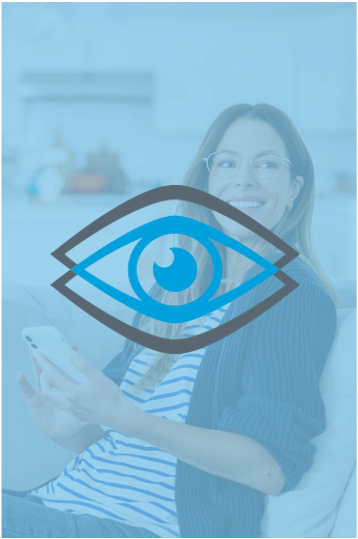
Neurolens Marketing
Nearly 2/3 of adults experience the painful symptoms of eye misalignment, including chronic headaches, neck pain, eye strain and dry eye sensation. Fortunately, relief is in sight with Neurolenses, which go beyond visual acuity to restore naturally comfortable vision.


.png)
.png)
.png)
-1.png)

